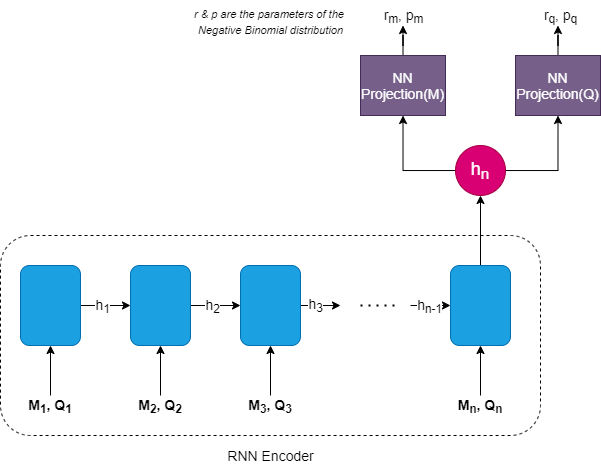GluonTS Implementation of Deep Renewal Processes
Intermittent Demand Forecasting with Deep Renewal Processes Ali Caner Turkmen, Yuyang Wang, Tim Januschowski
Installation
Recommended Python Version: 3.6
pip install deeprenewal
If you are working Windows and need to use your GPU(which I recommend), you need to first install MXNet==1.6.0 version which supports GPU MXNet Official Installation Page
And if you are facing difficulties installing the GPU version, you can try(depending on the CUDA version you have)
pip install mxnet-cu101==1.6.0 -f https://dist.mxnet.io/python/all
The sources for DeepRenewal can be downloaded from the Github repo_.
You can either clone the public repository:
git clone git://github.com/manujosephv/deeprenewal
Once you have a copy of the source, you can install it with:
python setup.py install
Model

Usage
Train with CLI
usage: deeprenewal [-h] [--use-cuda USE_CUDA]
[--datasource {retail_dataset}]
[--regenerate-datasource REGENERATE_DATASOURCE]
[--model-save-dir MODEL_SAVE_DIR]
[--point-forecast {median,mean}]
[--calculate-spec CALCULATE_SPEC]
[--batch_size BATCH_SIZE]
[--learning-rate LEARNING_RATE]
[--max-epochs MAX_EPOCHS]
[--number-of-batches-per-epoch NUMBER_OF_BATCHES_PER_EPOCH]
[--clip-gradient CLIP_GRADIENT]
[--weight-decay WEIGHT_DECAY]
[--context-length-multiplier CONTEXT_LENGTH_MULTIPLIER]
[--num-layers NUM_LAYERS]
[--num-cells NUM_CELLS]
[--cell-type CELL_TYPE]
[--dropout-rate DROPOUT_RATE]
[--use-feat-dynamic-real USE_FEAT_DYNAMIC_REAL]
[--use-feat-static-cat USE_FEAT_STATIC_CAT]
[--use-feat-static-real USE_FEAT_STATIC_REAL]
[--scaling SCALING]
[--num-parallel-samples NUM_PARALLEL_SAMPLES]
[--num-lags NUM_LAGS]
[--forecast-type FORECAST_TYPE]
GluonTS implementation of paper 'Intermittent Demand Forecasting with Deep
Renewal Processes'
optional arguments:
-h, --help show this help message and exit
--use-cuda USE_CUDA
--datasource {retail_dataset}
--regenerate-datasource REGENERATE_DATASOURCE
Whether to discard locally saved dataset and
regenerate from source
--model-save-dir MODEL_SAVE_DIR
Folder to save models
--point-forecast {median,mean}
How to estimate point forecast? Mean or Median
--calculate-spec CALCULATE_SPEC
Whether to calculate SPEC. It is computationally
expensive and therefore False by default
--batch_size BATCH_SIZE
--learning-rate LEARNING_RATE
--max-epochs MAX_EPOCHS
--number-of-batches-per-epoch NUMBER_OF_BATCHES_PER_EPOCH
--clip-gradient CLIP_GRADIENT
--weight-decay WEIGHT_DECAY
--context-length-multiplier CONTEXT_LENGTH_MULTIPLIER
If context multipler is 2, context available to hte
RNN is 2*prediction length
--num-layers NUM_LAYERS
--num-cells NUM_CELLS
--cell-type CELL_TYPE
--dropout-rate DROPOUT_RATE
--use-feat-dynamic-real USE_FEAT_DYNAMIC_REAL
--use-feat-static-cat USE_FEAT_STATIC_CAT
--use-feat-static-real USE_FEAT_STATIC_REAL
--scaling SCALING Whether to scale targets or not
--num-parallel-samples NUM_PARALLEL_SAMPLES
--num-lags NUM_LAGS Number of lags to be included as feature
--forecast-type FORECAST_TYPE
Defines how the forecast is decoded. For details look
at the documentation
An example of training process is as follows:
python3 deeprenewal --datasource retail_dataset --lr 0.001 --epochs 50
Train with Jupyter Notebook
dataset = get_dataset(args.datasource, regenerate=False)
prediction_length = dataset.metadata.prediction_length
freq = dataset.metadata.freq
cardinality = ast.literal_eval(dataset.metadata.feat_static_cat[0].cardinality)
train_ds = dataset.train
test_ds = dataset.test
trainer = Trainer(ctx=mx.context.gpu() if is_gpu&args.use_cuda else mx.context.cpu(),
batch_size=args.batch_size,
learning_rate=args.learning_rate,
epochs=20,
num_batches_per_epoch=args.number_of_batches_per_epoch,
clip_gradient=args.clip_gradient,
weight_decay=args.weight_decay,
hybridize=True) #hybridize false for development
estimator = DeepRenewalEstimator(
prediction_length=prediction_length,
context_length=prediction_length*args.context_length_multiplier,
num_layers=args.num_layers,
num_cells=args.num_cells,
cell_type=args.cell_type,
dropout_rate=args.dropout_rate,
scaling=True,
lags_seq=np.arange(1,args.num_lags+1).tolist(),
freq=freq,
use_feat_dynamic_real=args.use_feat_dynamic_real,
use_feat_static_cat=args.use_feat_static_cat,
use_feat_static_real=args.use_feat_static_real,
cardinality=cardinality if args.use_feat_static_cat else None,
trainer=trainer,
)
predictor = estimator.train(train_ds, test_ds)
deep_renewal_flat_forecast_it, ts_it = make_evaluation_predictions(
dataset=test_ds, predictor=predictor, num_samples=100
)
evaluator = IntermittentEvaluator(quantiles=[0.25,0.5,0.75], median=True, calculate_spec=False, round_integer=True)
#DeepAR
agg_metrics, item_metrics = evaluator(
ts_it, deep_renewal_flat_forecast_it, num_series=len(test_ds)
)
Check out the examples folder for notebooks
References
[1] Ali Caner Turkmen, Yuyang Wang, Tim Januschowski. "Intermittent Demand Forecasting with Deep Renewal Processes". arXiv:1911.10416 [cs.LG] (2019) [2] Alexander Alexandrov, Konstantinos Benidis, Michael Bohlke-Schneider, Valentin Flunkert, Jan Gasthaus, Tim Januschowski, Danielle C. Maddix, Syama Rangapuram, David Salinas, Jasper Schulz, Lorenzo Stella, Ali Caner Türkmen, Yuyang Wang;. "GluonTS: Probabilistic and Neural Time Series Modeling in Python". (2020).


